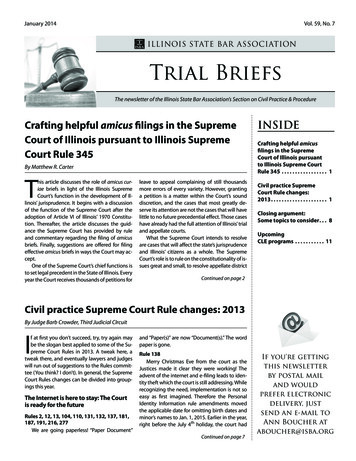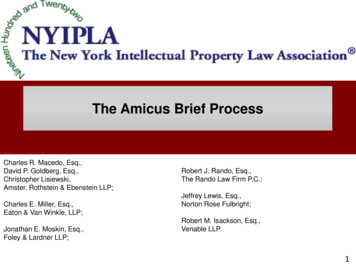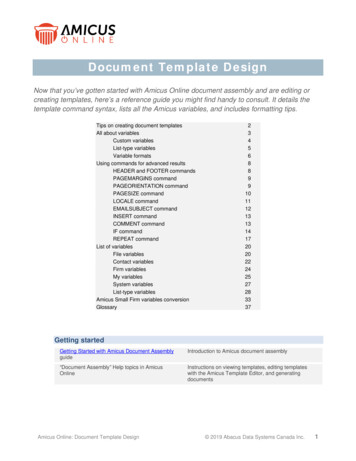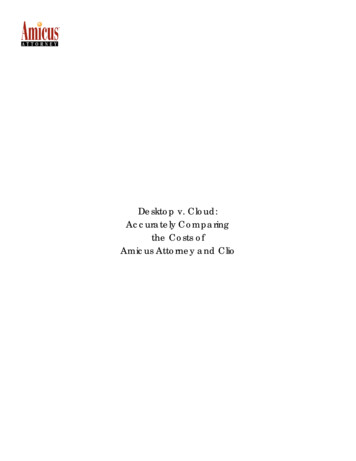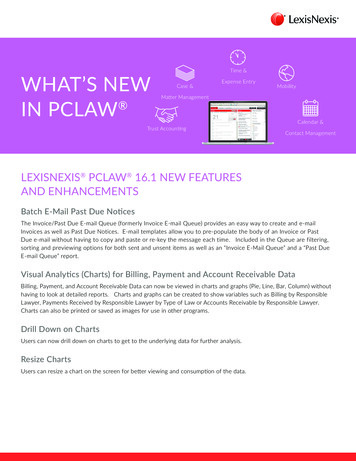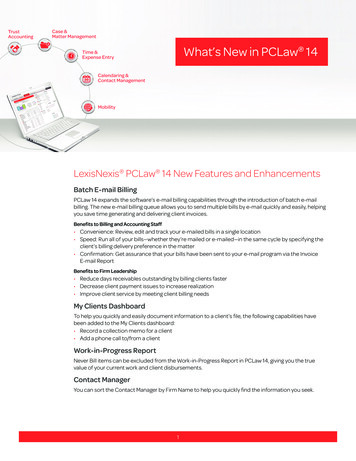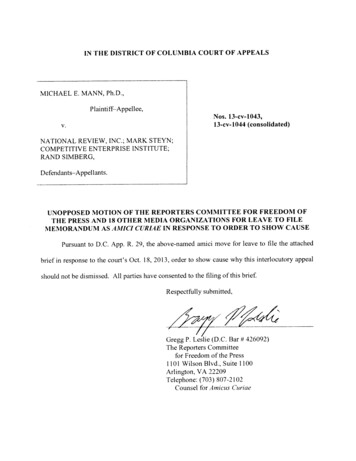
Transcription
IN THE DISTRICT OF COLUMBIA COURT OF APPEALS\IICI-IAEL E. MA\. Ph.D.Plaintiff—Appellee,Nos, 13-cv-1043,13-cv-1044 (consolidated)V.NATIONAL REVIEW. INC.: \IARK STEYN:COMPETITIVE ENTERPRISE INSTITUTE:RAND SIMBERG,Defendants—Appellants.UNOPPOSED MOTION OF THE REPORTERS COMMITTEE FOR FREEDOM OFTHE PRESS AND 18 OThER MEDIA ORG NIZATIONS FOR LEAVE [0 FILEMEMORANDUM AS AMICI CURL4E IN RESPONSE TO ORDER TO SHOW CAUSEPursuant to D.C. App. R. 29. the above-named amici move for leave to file the attachedbrief in response to the court’s Oct. IX, 2013, order to show cause why this interlocutory appealshould not be dismissed, All parties have consented to the filing of this briefRespectfully submitted,Gregg P. LeIie (D.C. Bar # 426092)The R.eporters G.ommitteefbr Freedom of the Press1101 Wilson Blvd., Suite iiAriinizton. VA 22209Felephone: (703) X07 —2102Counsel for :In2!cus Curiae
CER fIFICA FE OF SER ICEI hereh certify that on No. 13. 2013. a cops of the foregoing motion vas ser\ed byelectronic mail upon:DAVID 13. RIVKIN, JR.BR CE BROWNMARK I. BA [LENANDREW NI. GROSSMANBAKERHOSTETLER LLPWashington Square. Suite 1100I 050 Connecticut Avenue, N.W.Washington, D.C. 20036(202) 861-1770agrossman(a. bakerlaw. corn.1 Itorneys br AppellantsLotnpentnc Enterprise Jnstituteand Rand Sun bergSHANNEN W. COFFENJAMES MOORHEADtHOMAS CON FOISSTEP FOE & JOHNSON LLP1330 Connecticut A e., NW.Washington. D.C. 20036(202) 42Q-6255scoffintsteptoe,comIttorneyc for Appellants NationalReview, Inc., and Mark StevnJOHN B. WILLIAMSCATHERINE ROSATO REILLYCOZEN O’CONNOR P.C.1627 I Street, NW, Suite 1100Washington, D.C. 20006jbwi11iamsa. cozen.comIttorneys for Appellee .lfichael E. MannGregg P. LeslieThe Reporters Committeefor Freedom othe Press1101 Wilson Bhd Suite IluO&rlington, V& 22209I cphone (703) 07 10’(ounsel tor I ‘nk us ( !ir1ct
Nos, 1 3cv- 1043, 1 3-cv- 1044 (consolidated)DISTRICT OF COLUMBIA COURT OF APPEALSMichael E. Mann, PhD.,Plaintiff—Appellee,vNational Review, Inc.; Mark Steyn;Competitive Enterprise Institute; Rand Simberg,Defendants—Appellants.On Appeal from the Superior Court for the District of ColumbiaBRIEF AMIU CURIAE OF THE REPORTERS COMMITTEE FOR FREEDOM OFTHE PRESS AND 19 OTHER MEDIA ORGANIZATIONS IN SUPPORT OFAPPELLANTS, SUPPORTING A FINDING OF JURISDICTIONGregg P. LeslieThe Reporters Committeefor Freedom of the Press1101 Wilson Blvd. Suite 1100Arlington, VA 22209Telephone: (703) 807-2100Counsel for Amicus CuriaeAdditional counsel listed in Appendix B
TABLE OF CONTENTSTABLE OF AUTHORITIESiiSTATEMENT OF INTERESTivDISCLOSURE STATEMENTvSUMMARY OF THE ARGUMENT,.,.,.1ARGUMENTI.II.The right to avoid litigation of meritless claims against speech on a matter of publicinterest, as provided by the D.C. anti-SLAPP statute, will be irreparably lost if denial of aImotion is not immediatelyA.Three federal circuit courts have found, under the collateral order doctrine, that antiSLAPP statutes fall within the small class of interlocutory orders that are immediately2B.At least two states have found that anti-SLAPP statutes create immunity from suit, aright that is irreparably lost if denials of anti-SLAPP motions are not immediately4appealableC.Contrary decisions of other courts indicating there is no right to immediately appealthe denial of anti-SLAPP motions are distinguishable from the D.C. anti-SLAPPstatute because of the issue of immunity6The important role appellate courts play indefamation cases and the frequencywith which defamation decisions are overturned justify prompt appellate review8reviewingCONCLUSION10APPENDIX A: DESCRIPTION OF AMICI11APPENDIX B: ADDITIONAL COUNSEL16
11TABIE OF MTIIORITIESCasesJR. v, F.C, 33 A.3d 403 (D.C. 201 1).7Abbas v. Foreign Policy Grp., LLC, No. 12 1565, 2013 WL 5410410 (D.D.C. Sept. 27, 2013). 22,6Bar:elv. Smith, 333 F.3d 1018 (9th Cir. 2003)2Bolev v. Atlantic .Ionthlv Grp. \o. 13—89. 2013 WL 3185154 (D.D.C. June 25, 2013)8, 9Bose Coip. v. Consumei Union. 466 U.S. 485 (1984)Citizens Ass ‘ii of Georgetown v. Zoning C’omm ‘n of the District of Columbia. 392 A.2d 1027(D.C. 1978)7Cohen v. Beneficial Industrial Loan Corp., 337 U.S. 541(1949)22, 3, 4DC Comics v. Pac. Pictures Corp. 706 F.3d 1009 (9th Cir. 2013)4Elrodv. Burns, 427 U.S. 347 (1976)6. 7Englcrt v. MacDone/i. 551 F.3d 1099 (9th Cir. 2009)Fabre v. Walton. 781 N.E.2d 780 (Mass. 2002)4Godin v. Schencks, 629 F.3d 79(1st Cir. 2010)2.3.67,8Graysonv.AT&TCoip., 15 A.3d 219 (D.C. 2011)8flarte-Hanks Communications v. Connaughton, 491 U.S. 657 (1989)2, 3, 4Ifeniy v. Lake Charles Am. Press, L. L. C., 566 F.3d 164 (5th Cir. 2009).Ietahohc Research, Inc. v. Ferrell. 693 F.3d 795 (9th Cir. 2012)6, 7Webster. 772 A.2d 842 (Me. 2001)4. 5Iorsc Bros.l’ples Drug Stoc. Inc.i.Di1rkt ot Columbia. 17(1 A.2d “5! (DC. 1983).,,.7Schc/ling v. Linde/I. 942 A.2d 1226 (Me. 2008)5Stuart v. Walker. 6 A.3d 1215 (D.C. 2010)7Wendt v, Barnum, 2007 Mass. App. Di 93 (pp. Dix, 2007)Statutes.4, 5
111Cal. Civ. Proc. (odeD.C. Code16-5501425.16 (West 1992) (amended 2011).c’t seq.21. 5(2011)La. Code Civ. Proc. Ann. art. 971 (1999) (amended 2012)Mass. Gen. Laws ch. 231,Me. Rev. Stat. tit. 14,24§ 59H (1994) (amended 1996)2§ 556 (1999) (amended 2012)S.B. 286 (Nev. 2013) (amending Nev. Rev, Stat.§ 41.637)6Other AuthoritiesMLRC 2012 Report on Trials and Damages, Media L. Resource Center, Feb. 2012.9Report on Bill 18-893, “Anti-SLAPP Act of 2010,” Council of the District of Columbia,2, 6, 7, 9Committee on Public Safety and the Judiciary (Nov. 18, 2010)RulesD.C.App.R.2511D.C. App. R. 29i, iv
ivSTATEMENT OF INTERESTPursuant to DC. App. R. 29, the Reporters Committee for Freedom of the Press, throughundersigned counsel, respectfully submit this brief as amicus curiae in support of appellantsMark Steyn et al, and Competitive Enterprise Institute et a!. Pursuant to DC. App. R, 29 (a),this brief is filed with the consent of all parties.Media organizations have an interest in ensuring anti-S LAPP statutes remain effectivetools in protecting free speech. While all citizens who choose to speak out on public affairsbenefit from anti-SLAPP statutes, which aim to deter the use of litigation to silence speech, newsorganizations have an even greater interest in ensuring that these statutes provide meaningfulrelief. It is news organizations that choose every day to venture into the thick of every publiccontroversy they can find, to make sure citizens are fully informed about their world. Thisengagement with important issues makes the news media more liable to be drawn in to court,particularly when a controversial figure decides to use litigation as a weapon to counter thoroughreporting.The amicus parties are: The Reporters Committee for Freedom of the Press, AdvancePublications, Inc., Allbritton Communications Company, American Society of News Editors,Association of Alternative Newsmedia, Dow Jones & Company, Inc., The E.W, ScrippsCompany, First Amendment Coalition, The McClatchy Company, The National Press Club,NJational Press Photographers Association, NBCUniversal Media, LLC, News Corp, NewspaperAssociation of America, Online News Association, POLITICO LLC, Society of ProfessionalJournalists, Time Inc., Tribune Company, and The Washington Post, Each is described morefully in Appendix A.
DISCLOSURE STATEMENTAdvance Publications, Inc. has no parent corporation. and no publicly held corporationowns 10% or more of its stock.Allbritton Communications Company is an indirect, wholly owned subsidiary ofprivately held Perpetual Corporation and is the parent company of entities operating ABCaffiliated television stations in the following markets: Washington, D.C.; Harrisburg, Pa.;Binningham, Ala.: Little Rock, Ark.; Tulsa, Okia.; and Lynchburg, Va.American Society of News Editors is a private, non-stock corporation that has no parent.Association of Alternative Newsmedia has no parent corporation and does not issue anystock.The E.W. Scripps Company is a publicly traded company with no parent company. Noindividual stockholder owns more than 10% of its stock.News Corporation, a publicly held company, is the indirect parent corporation of DowJones. No publicly held company owns 10% or more of Dow Jones’ stock.First Amendment Coalition is a nonprofit organization with no parent company. It issuesno stock and does not own any of the party’s or amicus’ stock.The McClatchy Company is publicly traded on the New York Stock Exchange under theticker symbol MNI. Contrarius Investment Management Limited owns 10% or more of thecommon stock of The MeClatchy Company.The National Press Club is a not-for-profit corporation that has no parent company andissues no stock.National Press Photographers Association is a 501(c)(6) nonprofit organization with noparent company. It issues no stock and does not own any of the party’s or amicus’ stock.
viComcast Corporation and its consolidated subsidiaries own 100% of the common equityinterests of NBCUniversal Media, LLC.News Corporation has no parent company. and no publicly held company owns morethan 10 percent of its shares.Newspaper Association of America is a nonprofit, non-stock corporation organized underthe laws of the commonwealth of Virginia. It has no parent company.Online News Association is a not-for-profit organization. It has no parent corporation.and no publicly traded corporation owns 10% or more of its stock.POLITICO LLC is a wholly owned subsidiary of privately held Capitol News Company,LLC.Society of Professional Journalists is a non-stock corporation with no parent company.Time Inc. is a wholly owned subsidiary of Time Warner Inc., a publicly tradedcorporation. No publicly held corporation owns 10% or more of Time Warner Inc.’s stock.Tribune Company is a privately held company.WP Company LLC (dib/a The Washington Post) is a wholly-owned subsidiary of TheWashington Post Company, a publicly held corporation. Berkshire Hathaway, Inc., a publiclyheld company, has a 1 0 percent or greater ownership interest in The Washington Post Company.
SUMMARY OF THE ARGUMENTThe District of Columbia enacted the anti-SLAPP statute, D.C. Code§ 16-5501 et seq.(2011), to prevent claims based on speech about matters of public interest from advancing pastthe initial stages of litigation unless the plaintiff can demonstrate a likelihood of success on themerits. Michael Mann. a climate scientist, sued defendants for defamation regarding statementsthey made on blog posts about the controversy surrounding Mann’s research methods and data.Defendants moved to dismiss Mann’s complaint under the D.C. anti-SLAPP statute, The D.C.Superior Court denied the motions, prompting this appeal.This brief takes no position on the merits of the case; rather, it urges this court to find thatdenials of anti-SLAPP motions are immediately appealable. This decision would be consistentwith at least three federal circuits and two state high courts, which have found that anti-SLAPPstatutes are meant to conferimmunityand that the right not to be exposed to the costs and delaysof litigation will be irreparably lost if not immediately appealable. Furthermore, the high rate atwhich defamation decisions are overturned and the important role appellate courts play inreviewing defamation cases justify prompt appellate review.ARGUMENT1.The right to avoid litigation of meritless claims against speech on a matter of publicinterest, as provided by the D.C. anti-SLAPP statute, will be irreparably lost ifdenial of a motion is not immediately appealable.This court has not vet issued a published opinion determining whether interlocutoryorders denying anti-SLAPP motions are immediately appealable. However, other jurisdictionshave found that interlocutory orders denying anti-SLAPP motions must be immediatelyappealable to preserve the very rights conveyed to defendants under the statute.
Three federal circuit courts have found, under the collateral order doctrine.that anti-SLAPP statutes fall within the small class of interlocutory ordersthat are immediately appealable.A.Because of the lack of precedent from this court on the issue of appeals. it is appropriateto look to other jurisdictions for guidance. particularly when the law is based on similar laws inother states.Report on Bill 18893. “Anti-SLAPP Act of 2010,” Council of the District ofColumbia, Committee on Public Safety and the Judiciary (Nov. 18, 2010). at 4 (“CommitteeReport”) (“[This billj follows the model set forth in a number of other jurisdictions. .“).Infact. the U.S. District Court for the District of Columbia has looked to other jurisdictions forguidance when this issue has surfaced. See, e.g., Boiey v Atlantic Monthly Grp. No. 13—89,2013 WL 3185154. at *3 (D.D.C. June 25, 2013) (“Where appropriate, then, the Court will lookto decisions from other jurisdictions.for guidance in predicting how the D.C. Court ofAppeals would interpret its own aiiti-SLAPP law.”); Abbas v. Foreign Policy Gip., LLC, No. 12—1565. 2013 WL 5410410, at *3 (D.D.C. Sept. 27. 2013).The First, Fifth, and Ninth Circuits relied on the collateral order doctrine, see Cohen v.Bt’,ic,ficja/IndustrialLoan Chip.,337 U.S. 541 (1949), in finding that the anti-SLAPP statutes in3 respectively, required the right of immediate appeals to preserve2 and California,Maine,’ Louisiana,the purpose of the statutes. DC (‘omics v. Pac. Pictures Coip. 706 F.3d 1009 (9th Cir. 2013)(reaffirming Batzel v. Smith., 333 F.3d 1018 (9th Cir. 2003)); Godin v. Schencks, 629 F.3d 79 (1stCir. 2010): Henrr v. Lake Charles Am. Press. LL. C. 566 F.3d 164 (5th Cir. 2009).Thecollateral order doctrine permits immediate appeal of interlocutory orders “that are [(I)]conclusive, [(2)] that resolve important questions separate from the merits, and‘Me Rc Stat tit 14 556 (1999) ( imended 2012)La. Code Civ. Proc. nn, art. 971 (1999) (amended 2012).Proc (odL 42 i 6 (\\ cst 1Q92) amended 2u 1)C il[]that are
” DCeffectively unreviewable on appeal from the final judgment in the underlying action,Comics, supi’a, 706 F.3d at 1013 (brackets in original).The Ninth Circuit held that the first two criteria of the collateral order doctrine wereAPPclearly satisfied. Id. Analyzing the third criterion, the court held that the California anti-SLtostatute, based on the language of the statute and the legislative history behind it, was meantconfer immunity and not merely a defense against liability.id.immunity from suit isorderunreviewable on appeal from final judgnent; therefore, the third criterion of the collateraldoctrine was met. kL The Ninth Circuit noted that the protection of the right to free speechof theembedded in the anti-S LAPP statute requires “particular solicitude within the frameworkture’scollateral order doctrine.” Id. at 1016. The court further noted that “[t]he California legislaldetermination, through its enactment of the anti-SLAPP statute, that such constitutiona rightswould be imperiled absent a right of interlocutory appeal deserves respect.” Id.The First Circuit also found that the first two criteria of the collateral order doctrine weretomet before concluding that the rights created by the Maine anti-SLAPP statute were akinatimmunity and therefore unreviewable on appeal from final judgment. Godin, supra, 629 F.3dthat84-85. Looking at a Maine court’s decision granting interlocutory review, the court foundId.“lawmakers wanted to protect speakers from the trial itself rather than merely from liability.”at 85.The Fifth Circuit analyzed each criterion of the collateral order doctrine, ultimatelyoffinding that interlocutory orders denying an anti—SL PP motion fall under the “small class”thirdorders that are immediately appealable. Henry. sup/a. 566 F.3d at I 73—8 1. Regarding thethecriterion, the court found that anti-S LAPP statutes “provide defendants the right not to bearosts of fighting a mentles defamation claim” and art therefore unreiewahle on appeal from
4net to befinal judgment. Id. at 177-78. “[i]mmunity is not simply a right to prevail, but a rightNinth Circuit.tried.” and that right is lost if the case proceeds to trial, Id. at 177. Echoing theral orderwhich held that free speech protections should be given greater import under the collateprotectingdoctrine. DC Comfcs. 706 F.3d at 1016. the Fifth Circuit noted that the importance of566 F.3d atFirst Amendment rights “weighs profoundly in favor of appealability,” Henry, supra,tionably180. “The loss of First Amendment freedoms, for even minimal periods of time, unques).constitutes irreparable injury.” Id. (quoting Elrod 1’. Burns, 427 U.S. 347. 373 (1976)B.At least two states have found that anti-SLAPP statutes create immunityfrom suit, a right that is irreparably lost if denials of anti-SLAPP motions arenot immediately appealable.chusetts have likewise held that denial of anti-SLAPP motions are4Maine and Massaprovide for thatimmediately appealable, even though each of their statutes does not explicitly780right. Morse Bros. v. Webster, 772 A.2d 842 (Me. 2001): Fabre v. lEa/ton, 781 N.E.2d(Mass. 2002).Both courts focused their analyses on whether the right in question will bet of theirreparably lost if not immediately appealable, which is essentially the third elemenat 784.collateral order doctrine. Morse Bros., supra, 772 A.2d at 847; Fabre, supra, 781 N.E.2dsThe Massachusetts high court held that the right to avoid “the harassment and burden offorced tolitigation” is similar to government immunity in that the right is lost if the defendant isants maylitigate a case beyond its initial stages. Id. Not only did the high court find that defendheldimmediately appeal the denial of an anti-SLAPP motion, id., but an appellate courtafterdefendants must immediately appeal the interlocutory order or they lose their right to appealWendt. afinal judgment. Wcndt v. Barnum. 2007 Mass. App. Div. 93, 96 (App. Div. 2007). Ineddefendant fully litigated his case after his anti-S [APP motion was denied, and then he appealThc \l iss nuctts anti SL \PP tatutL an e to(amended 1996).at\i iGenLa‘n31H (1’ )4
Thethe anti-SLAPP order along with other claims of error. 2007 Mass, App. Div. at 93-97.thejudge dismissed the anti-SLAPP appeal as moot because the defendant failed to appealit isinterlocutory order immediately after it was issued. Id. at 96. Therefore, in Massachusetts,not mere speculation that a defendant loses his right under an anti-SLAPP statute if he cannotimmediately appeal the denial of his motion—it is a certainty.Much like the Massachusetts high court and the First, Fifth, and Ninth Circuits, theMaine high court found that anti-SLAPP statutes create a right to avoid the “cost and delay oflitigating [a] claim,” and forcing a defendant to continue litigation is the “precise harm that the942statute seeks to prevent.” Morse Bros., supra, 772 A.2d at 848; see also Scheiling v. Line/eli,A.2d 1226 (Me. 2008).The court noted that the statute was “designed to protect certaindefendants from meritless litigation,” as indicated by its provisions offering an expedited hearingtheon the motion and temporarily switching the burden of proof to the plaintiff. Id. Ultimately,court held that not immediately hearing an appeal of the denial of an anti-S LAPP motion wouldresult in the “loss of a substantial right.” IdLike the anti-SLAPP statutes in California, Louisiana, Maine, and Massachusetts, theD.C. anti-SLAPP statute confers a right to avoid the costs and harassment of meritless litigation—a right that will be lost if it is not immediately appealable. See D.C. Code§ 16-5501et seq.The D.C. anti-S LAPP statute is crafted to forestall litigation. See id. Much like the statute inMaine, see Morse Bros., supra, 772 A.2d at 848, the D.C. statute requires the court to hold anexpedited hearing, on the special motion to dismiss and shifts the burden to the plaintiff to provehis or her likelihood of success on the merits.D.C. Code16-5502 (b). (d). -5503 (b).Furthennore. it permits the court to award the costs of litigation to a party who prevails on aninti—Si APP motion mother dLtt.,rrcnttoli’ig mon1 6—04 (aD(lanni Lr\IeLgnized
6that the unique problem with SLAPP lawsuits “is that the goal of the litigation is not to win thelawsuit but punish the opponent and intimidate them into silence.” Committee Report at 4. Theanti-SLPP statute, then. is a remedy to the litigation itself. This brief takes no position as towhether the underlying merits of this ease fall within that class of “intimidating” SLAPP suits:rather, this brief fbcuses on the importance generally of immediately appealing denials of antiSLAPP motions. Just as the court in Godin stated, “lawmakers wanted to protect speakers fromthe trial itself rather than merely from liability.” 629 F.3d at 85. As the First, Fifth, and NinthCircuits have fbund. along with the high courts of Maine and Massachusetts. requiring a party tocontinue litigation before appealing the denial of an anti-SLAPP motion results in irreparableinjury—the exact injury the statute was meant to guard against.C.Contrary decisions of other courts indicating there is no right to immediatelyappeal the denial of anti-SLAPP motions are distinguishable from the D.C.anti-SLAPP statute because of the issue of immunity.The Ninth Circuit distinguished between California’s anti-SLAPP statute. Batel, supra,333 F.3d 1018, and Oregon’s, Engiert v. MacDoneli, 551 F. 3d 1099 (9th Cir. 2009), andNevada’s. Metabolic Research, Inc.i.Ferrell. 693 F.3d 795 (9th Cir. 2012), finding that appealsof anti-S LAPP motions are immediately appealable under California law but not under Oregonor Nevada law.California lawmakers intended to confer immunity, whereas Nevada’s andOregon’s lawmakers did not, the court held. See Metabolic Research. supra. 693 F.3d at 801. Inresponse to Metabolic Research, the Nevada legislature this year amended its statute so thatdenials of anti-SLAPP motions are immediately appealable. S.B. 286 Nev. 2013) (amendingNev. Rev. Stat.4 1.637).
Like California lawmakers. D.C. lawmakers intended to confer immunity from suit in theD.C. anti-S LAPP statute. The statute is silent as to whether interlocutory orders are immediatelappealable, hut the legislative history has much to say,This court has long recognized the importance of interpreting a statute through the lens ofits legislative history. A.)?. v. F.C. 33 A.3d 403, 405 (D.C. 2011) (“When interpreting a statute,the judicial task is to discern, and give effect to, the legislature’s intent.”); Grayson v. AT&Tcoip,, 15 A.3d 219, 238 (D.C. 2011) (en bane) (“In interpreting statutes, judicial tribunals seekto discern the intent of the legislature and, as necessary, whether that intent is consistent withfundamental principles of law,”); Peoples Drug Stores, Inc. v. District of Golumbia, 470 A.2d751, 754 (D.C. 1983) (‘This court has found it appropriate to look beyond the plain meaning ofstatutory language in several different situations.”). While the court must look first at the plainlanguage of the statute, Peoples Drug Stores, supra, 470 A.2d at 753, “the words [of a statute]‘cannot prevail over strong contrary indications in the legislative historyGrayson, supra,15 A.3d at 238 (quoting Citizens Ass ‘n of Georgetown v. Zoning Comm ‘ii of the District ofcolumbia, 392 A.2d 1027. 1033 (D.C. 1978)).Lawmakers originally included a provision panting a defendant the right of immediateappeal but later removed it solely because they thought the provision might exceed theirauthority, based this court’s decision in Stuart v. Walker, 6 A.3d 1215 (D.C. 2010); seeCommittee Report at 7. Even after lawmakers removed the provision, the report noted that the“Committee agrees with and supports the purpose of this provision.” Id.There is no need here, as in past cases, for this court to interpret ambiguous language orattempt to extrapolate the lawmakers’ intent. D.C. lawmakers clearly intended the anti-SLAPPstatutetoinclude the right to immediately appeal the denial of a special motion to dismiss. The
8D.C. anti-SLAPP statute is distinct from the Oregon and evada statutes, see MetabolicResearch. supra. 693 F.3d at 801:Engiert, supra.55 1 F.3d at 1105—06. as the intent to ensureimmediate appeal and confer immunity is clear in D.C. ‘s legislative history. As this court notedin Grayson, the words [of a statute] cannot prevail over strong contrary indications in thelegislative historylegislative history.15 A.3d at 238. Yet this court need not go so far as to seek ‘contrary’The statute may be read together with the legislative history to form acoherent interpretation, absent contradiction,The clear intention of the D.C. lawmakers to permit immediate appeals leads to a singleconclusion: the statute confers immunity from litigation, and that right is irreparably lost if thedenial of an anti-SLAPP motion isII.notimmediately appealable.The important role appellate courts play in rev iewing defamation cases and thefrequency with which defamation decisions are overturned justify prompt appellatereview.At its heart, this case is about getting an action before an appellate court promptly, so thatthe purpose of an anti-SLAPP motion—about speech on issues of public interestavoidance of litigation over non-meritorious claims—is not frustrated. Such appellate review has evengreater import in light of the role appellate courts often play in recoizing First Amendmentrights and supports the interest in allowing interlocutory appeals.The importance of searching appellate review in defamation cases has long beenestablished. See Hone-flanks Communications v. C’onnaughion, 491 US, 657. 685-86 (1989):Bose Corp.Consumers Union. 466 U.S. 485. 505 (1984). Because of Jo]ur profound nationalcommitment to the free exchange of ideas,” Uonnaughton, supra, 491 U.S. at 686. and theCourt’s tear that decisions by tncrs ot tact may inhibit thc expression ot protected ideas, Bose
9mustCorp., supra, 466 U.S. at 505, the Supreme Court has held that appellate judgesindependently review trial court findings of defamation, Bose Cotp.supra. 466 U.S. at 505.The question whether the evidence in the record in a defamation case is of theconvincing clarity required to strip the utterance of First Amendment protection isnot merely a question for the trier of fact. Judges, as expositors of theConstitution, must independently decide whether the evidence in the record issufficient to cross the constitutional threshold.Bose (Joip., supra, 466 U.S. at 511.This heightened appellate review has had a significant impact on the number offfsdefamation decisions overturned or modified. Between 1980 and 2011. defamation plaintiorwon 58.7 percent of their cases at trial, but defendants who appealed were able to reversees,modify nearly 70 percent of those decisions. See MLRC 2012 Report on Trials and DamagcasesMedia L. Resource Center. Feb. 2012, at 36 tbl.1, 74 tbl.12A (reporting that 145 out of215that were appealed, or 67.4 percent, were reversed or modified).The D.C. anti-SLAPP statute was enacted so that defendants in cases involving speech onissues of public interest could quickly have meritless claims dismissed before litigation coststhatbecame too burdensome, acting as a punishment in itself Committee Report at 4. Givend, seenearly 70 percent of defamation decisions that defendants appeal are overturned or reverseiateMLRC 2012 Report on 7}ials and Damages. supra, it is imperative to permit immedappellate review of denials of anti-SLAPP motions. It is not only burdensome on the parties butaa waste of the court’s limited time and resources to allow a defamation claim to linger in.lengthy and costly litigation that ultimately leads to an appeals process it is not likely to survive
(ONCU SIONtheFor the reasons gIen aboe, as eI1 as those gicn in the response of the appellant,anti-S L\PPcourt houId accept jurisdiction to hear an appeal of the denial of appellants’motions.Respectfully submitted.Gregg P. sIieThe Reporters Committeefor Freedom of the Press1101 Vilson Blvd., Suite 1100Arlington, VA 22209Telephone: (703) 807-2100Counsel for Amicus Curiae
11APPENDIX A: DESCRIPTION OF AMICIAdvance Publications, Inc., directly and through its subsidiaries, publishes iS magazineswith nationwide circulation, newspapers in over 20 cities and weekly business journals in over40 cities throughout the United States. It also owns many Internet sites and has interests in cablesystems serving over 2.3 million subscribers.Alibritton Communications Company is the parent company of entities operating ABCaffiliated television stations in the following markets: Washington, D.C.; Harrisburg, Pa.; Birmingham, Ala.: Little Rock, Ark.: Tulsa. OkIa.; and Lynchburg. Va. In Washington, it operatesbroadcast station WJLA-TV, the 24-hour local news service, NewsChannel 8 and the news website WJLA.com. An afliliated company operates the ABC affiliate in Charleston. S.C.With some 500 members. American Society of News Editors (‘ASNE”) is an organization that includes directing editors of daily newspapers throughout the Americas. ASNE changedits name in April 2009 to American Society of News Editors and approved broadening its membership to editors of online news providers and academic leaders. Founded in 1922 as AmericanSociety of Newspaper Editors, ASNE is active in a number of areas of interest to top editors withpriorities on improving freedom of information. diversity. readership and the credibility of newspapers.Association of Alternative Newsmedia (“AAN”) is a not-for-profit trade association for130 alternative newspapers in North America, including weekly papers like The Village Voiceand Washington City Paper. AAN newspapers and their websites provide an editorial alternativeto the mainstream press. AAN members have a total weekly circulation of seven million and areach of over 25 million readers.
Dow Jones & Company. Inc., a global provider of news and business information, is thepublisher of The Wall Street Journal, Barron’s
INSTITUTE: RAND SIMBERG, Defendants Appellants. Nos, 13-cv-1043, 13-cv-1044 (consolidated) UNOPPOSED MOTION OF THE REPORTERS COMMITTEE FOR FREEDOM OF THE PRESS AND 18 OThER MEDIA ORG NIZATIONS FOR LEAVE [0 FILE MEMORANDUM AS AMICI CURL4E IN RESPONSE TO ORDER TO SHOW CAUSE Pursuant to D.C. App. R. 29. the above-named amici move for leave to file .


